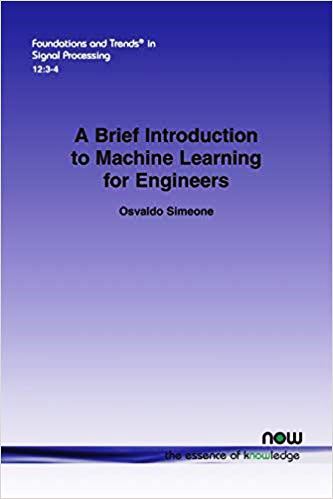| Book Name: | A Brief Introduction to Machine Learning for Engineers |
| Category: | Machine Learning |
| Free Download: | Available |
A Brief Introduction to Machine Learning for Engineers

Book Description:
This monograph aims to provide an introduction to the key concepts, algorithms and theoretical outcomes of machine learning. Treatment focuses on probabilistic models for supervised and unsupervised learning disorders. It introduces basic concepts and algorithms that are based on first principles and exposes readers to more advanced topics with extensive hints on the material, within a framework of notation and mathematics. unified learning. The material is organized into well-defined categories, such as discriminating and synthetic models, regularism and Bayesian approaches, exact and approximate inference, and direct and undirected models. This monograph is intended to be a contribution to researchers with technical training in probability and linear algebra.
Table of contents :
I. Basics
1. Introduction
1.1 What is Machine Learning?
1.2 When to Use Machine Learning?
1.3 Goals and Outline
2. A Gentle Introduction through Linear Regression
2.1 Supervised Learning
2.2 Inference
2.3 Frequentist Approach
2.4 Bayesian Approach
2.5 Minimum Description Length (MDL)
2.6 Information-Theoretic Metrics
2.7 Interpretation and Causality
2.8 Summary
3. Probabilistic Models for Learning
3.1 Preliminaries
3.2 The Exponential Family
3.3 Frequentist Learning
3.4 Bayesian Learning
3.5 Supervised Learning via Generalized Linear Models (GLM)
3.6 Maximum Entropy Property
3.7 Energy-based Models
3.8 Some Advanced Topics
3.9 Summary
II. Supervised Learning
4. Classification
4.1 Preliminaries: Stochastic Gradient Descent
4.2 Classification as a Supervised Learning Problem
4.3 Discriminative Deterministic Models
4.4 Discriminative Probabilistic Models: Generalized Linear Models
4.5 Discriminative Probabilistic Models: Beyond GLM
4.6 Generative Probabilistic Models
4.7 Boosting
4.8 Summary
5. Statistical Learning Theory
5.1 A Formal Framework for Supervised Learning
5.2 PAC Learnability and Sample Complexity
5.3 PAC Learnability for Finite Hypothesis Classes
5.4 VC Dimension and Fundamental Theorem of PAC Learning
5.5 Summary
III. Unsupervised Learning
6. Unsupervised Learning
6.1 Unsupervised Learning
6.2 K-Means Clustering
6.3 ML, ELBO and EM
6.4 Directed Generative Models
6.5 Undirected Generative Models
6.6 Discriminative Models
6.7 Autoencoders
6.8 Ranking
6.9 Summary
IV. Advanced Modelling and Inference
7. Probabilistic Graphical Models
7.1 Introduction
7.2 Bayesian Networks
7.3 Markov Random Fields
7.4 Bayesian Inference in Probabilistic Graphical Models
7.5 Summary
8. Approximate Inference and Learning
8.1 Monte Carlo Methods
8.2 Variational Inference
8.3 Monte Carlo-Based Variational Inference
8.4 Approximate Learning
8.5 Summary
V. Conclusions
Appendices
A. Appendix A: Information Measures
A.1 Entropy
A.2 Conditional Entropy and Mutual Information
A.3 Divergence Measures
B. Appendix B: KL Divergence and Exponential Family
Acknowledgements
References
A Brief Introduction to Machine Learning for Engineers
Author(s): Osvaldo Simeone
Series: Foundations and Trends in Signal Processing
Publisher: Now Publishers, Year: 2018
ISBN: 168083472X, 9781680834727









![[PDF] Draw Buildings and Cities in 15 Minutes Draw Buildings and Cities in 15 Minutes pdf](https://www.freepdfbook.com/wp-content/uploads/2021/06/Draw-Buildings-and-Cities-in-15-Minutes-218x150.jpg)








![[PDF] Digital Image Processing An Algorithmic Introduction Using Java Digital Image Processing An Algorithmic Introduction Using Java](https://www.freepdfbook.com/wp-content/uploads/2022/06/Digital-Image-Processing-An-Algorithmic-Introduction-Using-Java.jpg)




![[PDF] 43 Years JEE ADVANCED + JEE MAIN Chapterwise & Topicwise Solved Papers 43 Years JEE ADVANCED (1978-2020) + JEE MAIN Chapterwise & Topicwise Solved Papers Physics PDF](https://www.freepdfbook.com/wp-content/uploads/2022/03/43-Years-JEE-ADVANCED-1978-2020.jpg)

![[PDF] Problems in Physical Chemistry for JEE (Main & Advanced) Problems in Physical Chemistry for JEE (Main & Advanced) Free PDF Book Download](https://www.freepdfbook.com/wp-content/uploads/2022/03/Problems-in-Physical-Chemistry-for-JEE-Main-Advanced.jpg)
![[PDF] Engineering Physics (McGraw Hill)](https://www.freepdfbook.com/wp-content/uploads/2021/05/bafc8c2685bb6823a9c56134f7fba5df.jpeg)

![[PDF] Engineering Chemistry By Shashi Chawla](https://www.freepdfbook.com/wp-content/uploads/2022/05/Theory-And-Practicals-of-Engineering-Chemistry-By-Shashi-Chawla-free-pdf-book.jpeg)
![[PDF] Chemistry: An Introduction to Organic, Inorganic & Physical Chemistry Chemistry: An Introduction to Organic, Inorganic & Physical Chemistry](https://www.freepdfbook.com/wp-content/uploads/2022/04/Chemistry-An-Introduction-to-Organic-Inorganic-Physical-Chemistry.jpg)
![[PDF] Essentials of Physical Chemistry Essentials of Physical Chemistry Free PDF Book by Bahl](https://www.freepdfbook.com/wp-content/uploads/2022/04/Essentials-of-Physical-Chemistry-bahl.jpg)
![[PDF] Biological control of plant-parasitic nematodes: soil ecosystem management in sustainable agriculture Biological control of plant-parasitic nematodes: soil ecosystem management in sustainable agriculture](https://www.freepdfbook.com/wp-content/uploads/2022/05/Biological-control-of-plant-parasitic-nematodes-soil-ecosystem-management-in-sustainable-agriculture.jpg)
![[PDF] Human Anatomy: Color Atlas and Textbook Human Anatomy: Color Atlas and Textbook Free PDF Book](https://www.freepdfbook.com/wp-content/uploads/2022/05/Human-Anatomy-Color-Atlas-and-Textbook.jpg)
![[PDF] Concepts of Biology Book [Free Download]](https://www.freepdfbook.com/wp-content/uploads/2022/05/Concepts-of-Biology.jpg)
![[PDF] Essentials of Biology [Free Download] Essentials of Biology Free PDF BOok Download](https://www.freepdfbook.com/wp-content/uploads/2022/05/Essentials-of-Biology-Free-PDF-Book-Downlaod.jpg)
![[PDF] Human Biology Book [Free Download]](https://www.freepdfbook.com/wp-content/uploads/2022/05/PDF-Human-Biology-Book-Free-Download.jpg)


